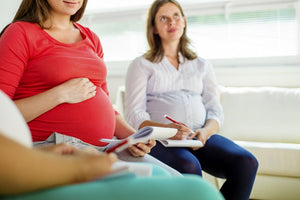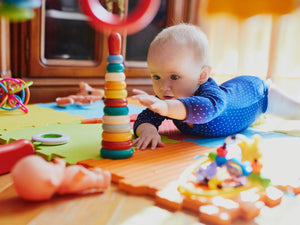“A bird doesn’t sing because it has an answer, it sings because it has a song.” – Maya Angelou, poet and civil rights activist
Babies show a preference for human voices over other sounds of a similar quality. This preference is partly due to their familiarity with voices from the womb. Attuned parents soon discover the most pleasing pitch, volume and tones of sound for their baby in order to arouse their interest or calm them down. Individual differences play a part. Some babies are more sensitive to sound, either through temperament or from their early experiences. From a few months old, infants attempt to influence or direct the attention of others through their preverbal sounds and movement.
Vocalising is a way of communicating and of expressing oneself and one’s feelings. Vocalising is a way of sharing an experience or point of view, and creates opportunities for ‘being with’ and understanding each other.
Parent-infant interaction using vocalisations promotes synchrony, like a dance. Upon hearing her mother’s voice, a newborn will synchronise her movements to her mother’s sounds, to which Mum then responds by matching her vocalising to her baby’s movement, and so on. In this way, synchrony and reciprocity (turn-taking) naturally occur. Turn-taking between you and your baby in preverbal communication is important so each of you can have your say and be heard. This builds a sense of partnership in relationships and is the beginning of conversations.
Being mindful of following your baby’s lead and imitating your baby’s vocalisations will promote feelings of togetherness for you both.
For instance, she makes a sound and you then imitate her when she pauses. This might be followed by a giggle from her and then a repeat of the sound, to which you will again imitate. With vocalising, try to imitate the sound quality in pitch, tone and volume, although you will probably exaggerate your imitation somewhat. When you follow her lead like this, she feels heard and understood by you, which fosters closeness. When she makes a sound and then you make a sound, at some level she experiences that she made that happen – she created a situation where you responded. This experience gives her a sense that she can have some control over her environment – if she reaches out in some way by communicating, she is heard and responded to.
Joanna and Abby
Four-month old Abby was lying on her back, her hands lightly clasped. She was very chatty. Abby and her mum Joanne were in conversation and their mutual gaze was strong. Joanne was crouched over Abby with a good distance between their eyes to hold gaze. Abby was talking, “Ooohha, ooohhha. Oooooa, a-oohhhhaa. Ooooo, oooo”. Joanne listened intently and responded, “Really? That’s a good story. What else do you have to tell me?” Abby looked at her when she was talking and had a slightly furrowed brow. Then she looked into the distance at the ceiling and answered, “Oooh. Oooh. A-ooohhhaa.” Joanne confirmed her communication, “Ooohhaa. That’s right. Ooohhaa.” Abby again looked back at her and held her gaze as she spoke. Abby smiled as though it felt good to be confirmed and put her hands in her mouth.
Parents need to develop many voices in relation to their infant: a voice to excite, stimulate and arouse; a voice to calm, soothe and reassure; a voice to entertain and distract; a voice to imitate. Infants need this range of expression and communication from their parents. When you are attuned to her mood and can vocalise with the closest ‘voice’, your baby will feel heard and understood. One of your voices may be a ‘singing voice’, which infants seem to love regardless of the skill level of the parent! It is important for infants to hear the musicality within their parent’s happy voice. We tend to have a sing-song element in our vocal communications when we feel a sense of joy or connectedness – infants need to hear this. There is a musical element in human interaction and communication. Try to notice the musicality in your interactions. What do you notice in terms of rhythm, tone, pitch, volume and tempo? Remember, babies need pauses in interactions of any kind, and this applies to vocal conversations too.
Have a conversation with your baby: listen, talk, share, pause.
About the Author
Dr Bronwyn Leigh is the Director of the Centre for Perinatal Psychology – a hand-picked Australia-wide network of psychologists specialising in the emotional wellbeing of parents and infants before and during pregnancy, and the three years following the birth of a baby. She consults in Fairfield, Vic, and also enjoys facilitating her Mindfully Parenting Your Baby group program. Bronwyn co-authored the book Towards Parenthood: Preparing for the Changes and Challenges of a New Baby.
Our Products
-

01. Guide to a Healthy Pregnancy
$55 -

02. Positive Birthing Course
$55 -

03. Infant Feeding Guide
$55 -

04. Baby Sleep Guide - First 12 Months
$55 -

05. Toddler Parenting Course 1 - 3 Years
$55
-
 When to Start Antenatal Classes?
When to Start Antenatal Classes?
Becoming a parent is an incredible milestone, but it comes with a host of changes that can be daunting, especially for first time parents. Antenatal classes are all about offering expectant parents the education they need to make informed decisions, look after their bodies and care for their newborn babies. While you probably already have a long list of things you need to accomplish during your pregnancy, it’s a good idea to make time to attend antenatal classes.
-
 Development Milestones 4-8 Months
Development Milestones 4-8 Months
As they reach the middle of their first year, you'll start to see bigger leaps in their growth and ability!
In this article, we’re going to discuss your baby’s developmental milestones between 4-8 months, and what you can expect along the way.





 When to Start Antenatal Classes?
When to Start Antenatal Classes?
 Development Milestones 4-8 Months
Development Milestones 4-8 Months








